5 Expressionist Artists You Should Know
The purpose of art for a group of avant-garde individuals at the turn of the 20th century was no longer the realistic rendition of the natural world,...
Guest Profile 29 February 2024
By 1902, Edvard Munch’s life had seen a pattern of chaos within his professional life, his health, and his love life. While his life had become solitary, his artwork was not destined to remain stacked against the walls, as was his habit. In fact, this was the year when his almost random collection of paintings became a representation of the cycle of life itself and thus known as The Frieze of Life.
Unappreciated in his home country, the work that went out to Paris and Berlin had given Munch a reputation among the young artists of France and Germany. Therefore it was to Berlin that Munch returned, to a place that ten years earlier had seen a change in his fortunes.
1892 had been an important year for Munch. His first exhibition in Berlin in the newly built Architektenhaus ended in closure by the very people who had invited him to display his work. The Verein (The Association of Berlin Artists) held an extraordinary meeting on November 11th, and in a vote of 120 to 105 it was decided to close the exhibition. This left Munch perplexed as to why he had been invited in the first place.
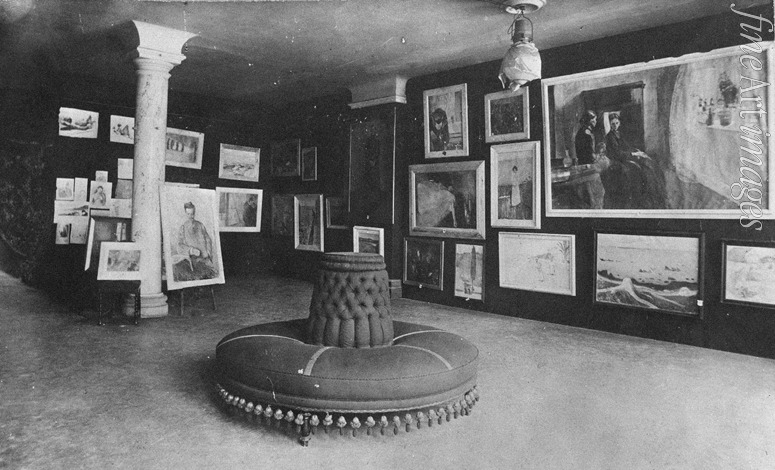
However, the younger members were not prepared to put up with such an insult to an invited guest. They broke away from the traditionalist stance of the Verein to form their own group: The Berlin Secession.
Ten years later, Munch decided to once again live and work in Berlin looking, ironically, for isolation. But he did not count on the friendship he developed with Max Liebermann, the president of the Secession. It was Liebermann who gave Munch the distinctly unimpressive title, Presentation of a Number of Images of a Life, to work from.
This vague title gave Munch the opportunity to display paintings he had been working on over the past ten years, ever since he had seen the vision in his room in Paris in 1890 that went on to inspire the beautiful Night in Saint-Cloud and place them in a logical order of narrative.
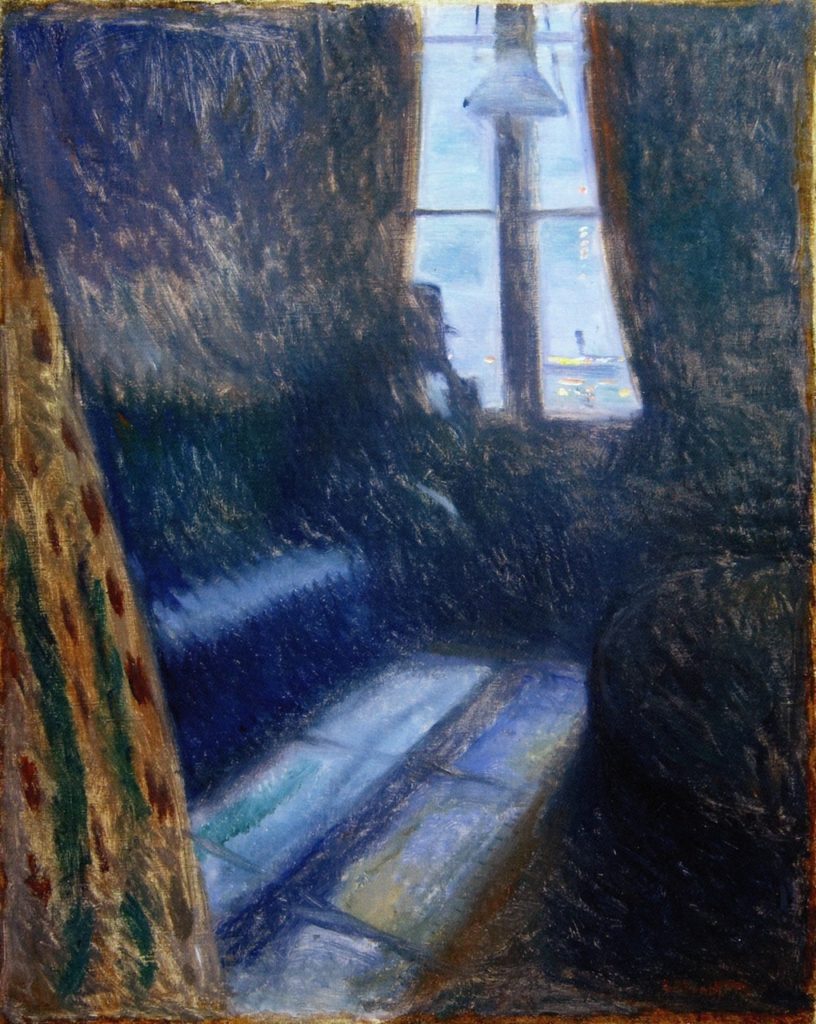
The night that Munch’s father died was a turning point for him. At that time, he was living in a small room in Saint-Cloud. Practically destitute, drinking heavily, and hallucinating from the effect of absinthe, the visions he experienced came to him as “The Saint-Cloud Manifesto.”
In her book, Edvard Munch: Behind the Scream, Sue Prideaux gives us some deep insights into Munch’s thought processes through his diary entries. In his diary, Munch wrote:
There should be no more pictures of interiors, of people reading and women knitting. / There would be pictures of real people who breathed, who suffered, felt, loved. / I felt impelled – it would be easy. The flesh would have volume – the colors would be alive.
Edward Munch in Sue Prideaux: Edvard Munch: Behind the Scream, 2005 Yale University Press.
From this he was able, at last, to portray his father on canvas; an ambiguous painting that says more about Munch than his father.
The painting is stunning with the deep blue, melancholic palette flooding the canvas just as the moonlight penetrates the window. The figure sits at the windowsill staring out onto the bright Parisian lights, perhaps envious, but more likely lonely. The reflection of the window frame creates the sign of the cross on the floor linking it to Munch’s religious upbringing.
The outpouring of emotion onto canvas was not in any particular order, but when Munch came to curate the exhibition, he found that he could divide the works into four categories: Seeds of Love, The Flowering and Passing of Love, Anxiety, and finally, Death.
Beginning with the early stages of love all placed together on the first wall, we can see how Munch was telling a story. Seeing the girl in a natural setting gives an idealistic view of love but in the next image, Red and White, there seems to be a temptress standing between him and a suitable girl that he should marry. The works that follow tell a story of a love affair.
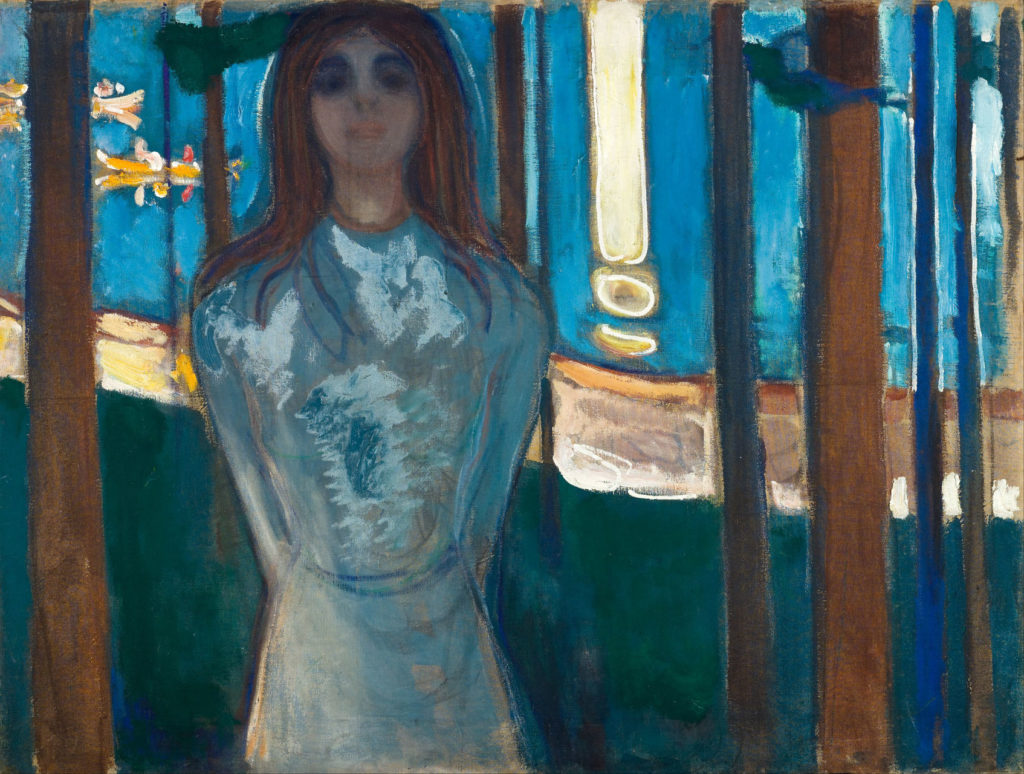
We can almost apply this narrative to Munch’s own life. His first real romance was with Millie Thaulow, the wife of a captain in the medical corps and mainstays of Oslo society, where she already had a reputation amongst Munch’s fellow artists. Munch was attracted to the older woman from the start and their many encounters were described by him in his diaries. Written as a narrative, with pseudonyms for the protagonists, it is a tale of teasing by the more experienced woman on a besotted young man:
He took her round the waist – she pressed against him- everything vanished, trees, air, something wonderful possessed him – he felt warm lips on his neck – a wet cheek against his own – and his mouth sank softly into hers.
Edward Munch in Sue Prideaux: Edvard Munch: Behind the Scream, 2005 Yale University Press.
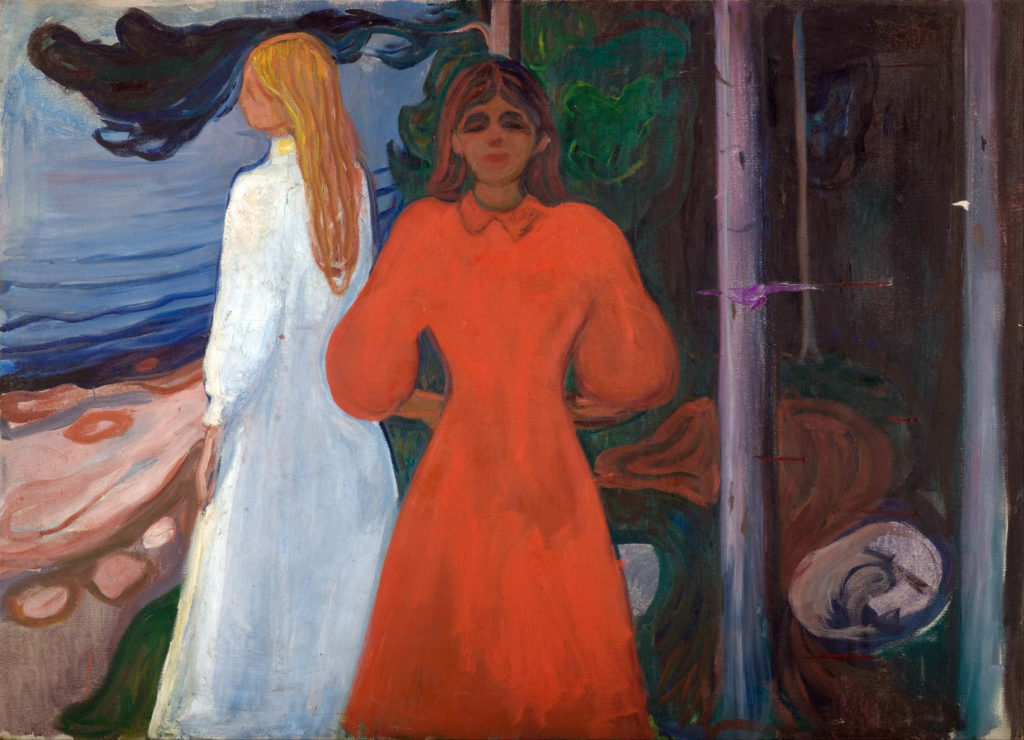
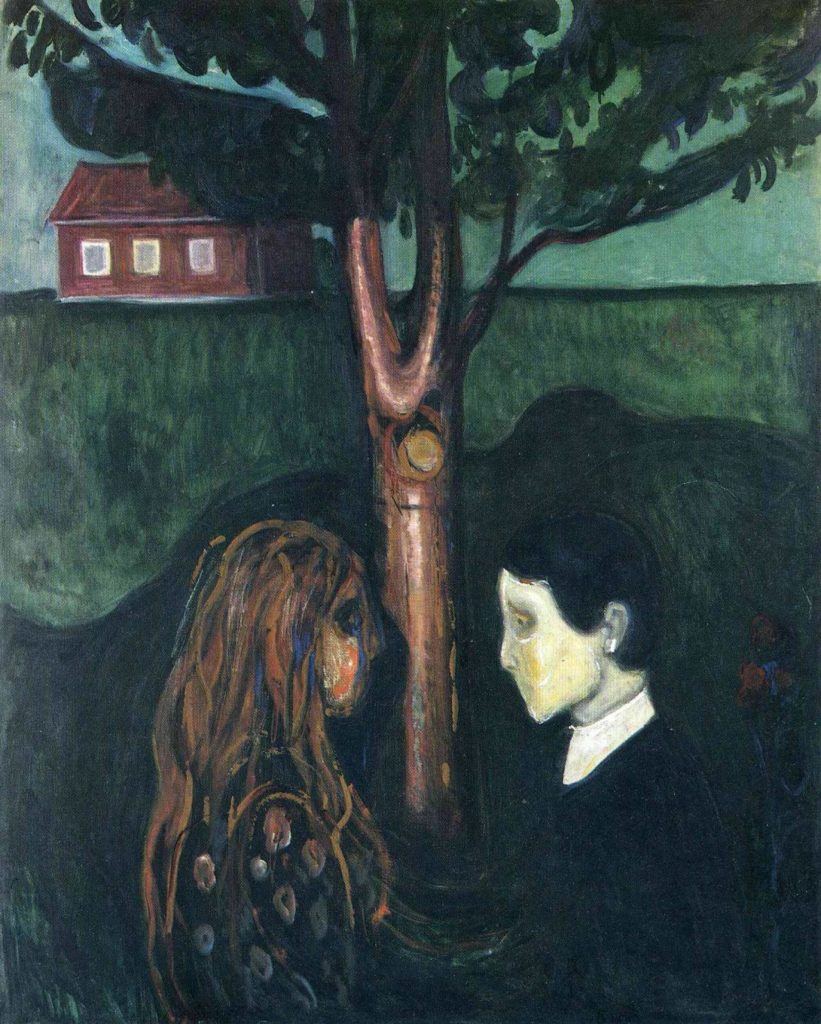
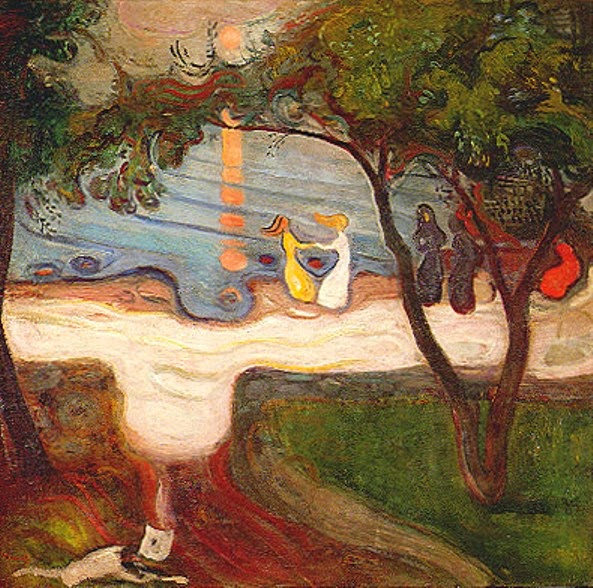

In this painting, simply entitled The Kiss, Munch is exploring more than the physical act of love. It is about the connection, body, mind, and soul that unites two people. In The Kiss, there is a tenderness that has been lacking in the previous works; the two are unending, you cannot tell where one begins and the other ends. They are “fully united.”
Furthermore, it appears that this is what he searched for his entire life, something that was not to be found within his affair with Millie Thurlow, which he described in this way:
Human fates are like planets / Like a star that emerges / from the dark – / and meets another star – / shines for a second before disappearing again / into the dark – [it is] in this way – in this way / a man and a woman meet – glide towards / one another are illuminated in love’s / flames – to then disappear / in their separate directions – / Only a few meet in a / single large blaze – where they both / can be fully united
Magne Bruteig, Maite Van Dijk: Munch : Van Gogh, 2015 Munch Museum.
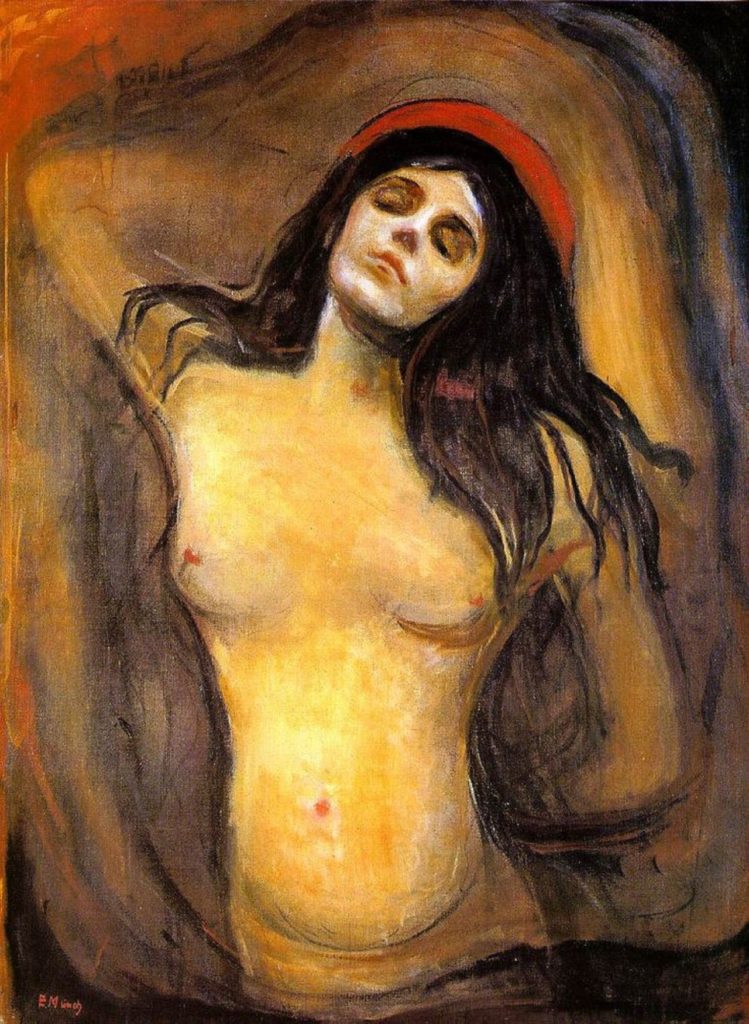
The affair culminated with his painting of Madonna. Although the model was not Thaulow, we can see how Munch’s Madonna appears to be in a state of ecstasy that ties in with Munch’s diary entries.
Women he was with were part of the Bohemian life he had been drawn to, but where he remained on the outside. Munch’s problem came when they returned to their husbands and he was left with his own thoughts that were governed by his religious upbringing. To quote from his diary of the time he lost his virginity:
He thought it terrible that he should go to her – and terrible that she knew what he wanted…he would not look at her. He wanted the thing he had dreamed of. He lay on top of her – he wanted – / They said nothing – he felt humiliated – a tremendous tiredness and sorrow. She stroked his hair. / ‘Poor boy’ / He walked away with his head in his hands. ‘Thou shalt not commit adultery’, the Commandment rang out in his father’s voice. He had committed adultery. All of a sudden it was all so ugly.
Edward Munch in Sue Prideaux: Edvard Munch: Behind the Scream, 2005 Yale University Press.
Her patronizing stroking of his hair and pity would only enhance his feeling that she is the one who was in control of the sexual experience and who could walk away with no regrets, while he was left with his “head in his hands” full of despair and guilt of having committed adultery. An image that we can see all too clearly in the next section.
In this section, Munch placed the works that seemed to symbolize what goes wrong after the initial passion fades.
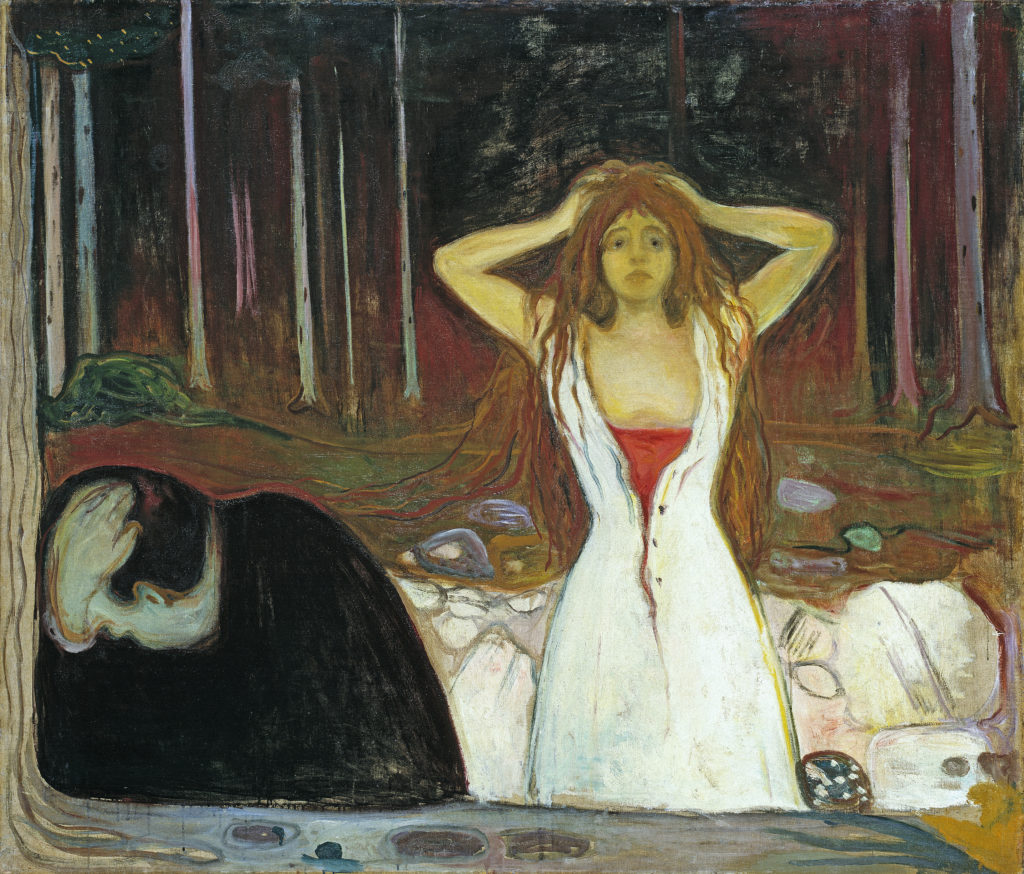
The first painting in this section was entitled Ashes. In this work, traditional sexual roles are reversed. As in Three Stages of Woman, the male is reduced to a passive wreck and contrasts with the woman who rejoices in her sexuality. The question we need to ask is, why this has occurred? We are already aware that Munch felt “humiliated – a tremendous tiredness and sorrow” following his sexual experience in the forest. In her biography of Munch, Sue Prideaux ascribes this to the affair with Thaulow:
He feared the power that seemed to energize her after lovemaking, while he felt empty unto death, drained of both free will and power. Weakness and shame, fear and desire were ambivalently linked at the moment of union that provided a glimpse into the abyss beyond, the realm of sin and death.
Edward Munch in Sue Prideaux: Edvard Munch: Behind the Scream, 2005 Yale University Press.
Prideaux reinforces this with a quotation from Munch: “I felt our love lying on the ground like a heap of ashes.”
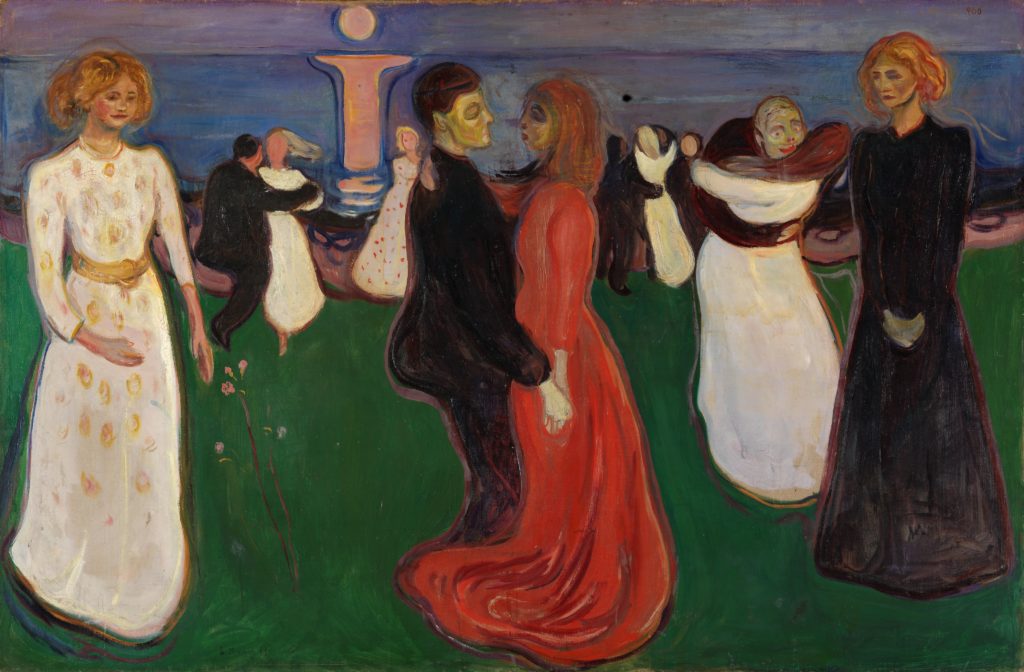
The Dance Of Life and Woman in Three Stages are intrinsically linked. Symbolic imagery is rife in both of these works: The young, virginal girl on the left, always clad in white and who appears to be waiting, breathlessly for the moment in which she becomes a woman. To the right, the woman at the end of her sexual cycle looks back, sometimes with regret, but often with the look of the corpse about her.
In the center is the sexual being, the “procreator”; the woman at the height of her sexuality, arms raised, back arched, and prime for the taking. Or, is she the temptress, in red, gazing lovingly, wantonly, into another’s eyes? Using the metaphor of dance for love-making, Munch makes it clear through the positioning of the couple in the center of The Dance of Life, that this moment is the mainstay of existence. The dress is entwined around the couple, leading us to see that it is the woman who leads the ‘dance’.
It is believed that Munch was inspired by lines in a play written by his friend, Helge Rode, called Dansen Gaar (The Dance Goes on) when one of the characters says:
The dance of life – my picture shall be called The Dance of Life! There will be a couple dancing, in flowing garments.… He holds her tightly. He is deeply serious and happy.… He will hold her so tight that she halfway merges with him.… He fills her with strength.
Edvard Munch in the National Museum, 2008 National Museum of Norway.
This appears life-affirming in the extreme; the idea of two merging to become one. However this seems to be difficult for Munch in his art as well as his life, and it is a theme he returns to much later on. The reason for this is while Rode makes the male lover the one who “fills her with strength”, for Munch, it was the reverse situation. The woman in Dance is clearly in control and, if we look carefully at Woman in Three Stages and Melancholy, the man plays an unexpected role: the loser in love.

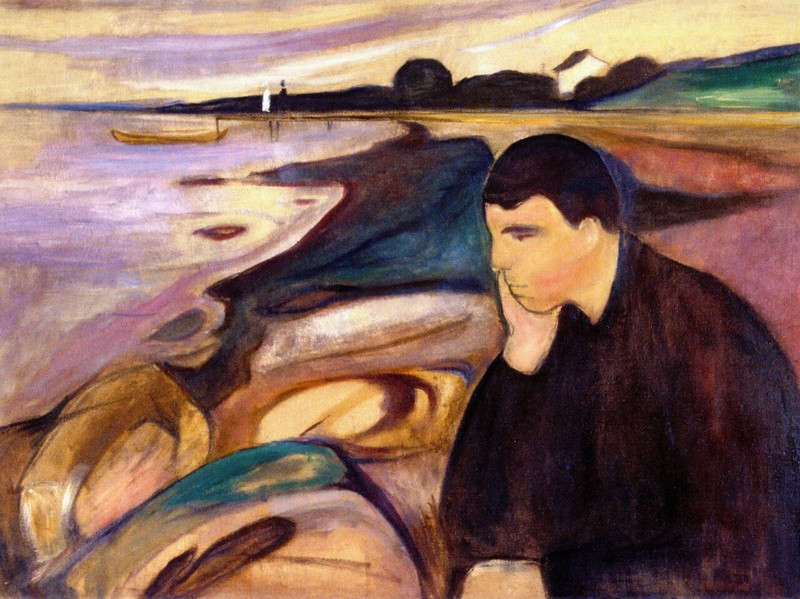
However, Munch seems to be placed in an unfulfilled role in his relationships and this fits more with the figure in Ashes. With Thaulow, his jealousy and obsession began to impact his work. In his diary, he wrote feverishly of how she caused him to feel “the entire unhappiness of love”:
Was it because she took my first kiss that she took away my life’s breath? Was it that she lied – she deceived – that suddenly one day the scales fell away from my eyes and I saw a Medusa head and I saw life as a thing of terror.
Edward Munch in Sue Prideaux: Edvard Munch: Behind the Scream, 2005 Yale University Press.
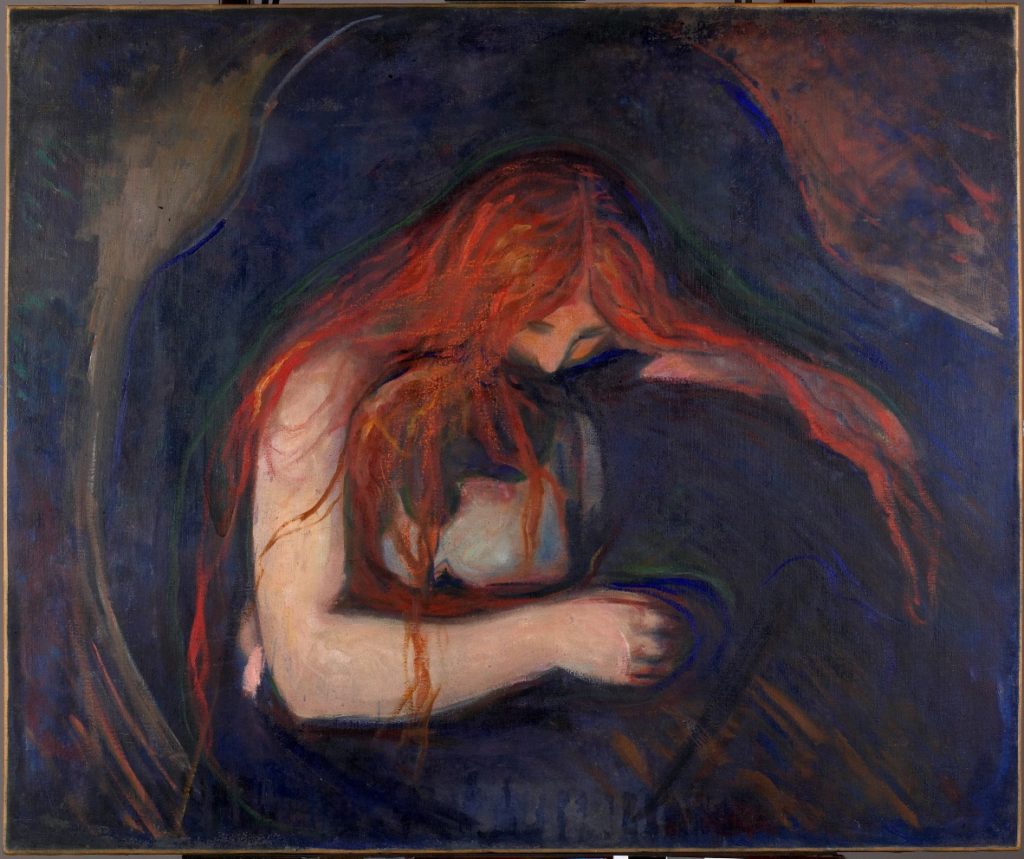
The lover turning into the monster is the theme he addressed in the works that became known as Vampire.
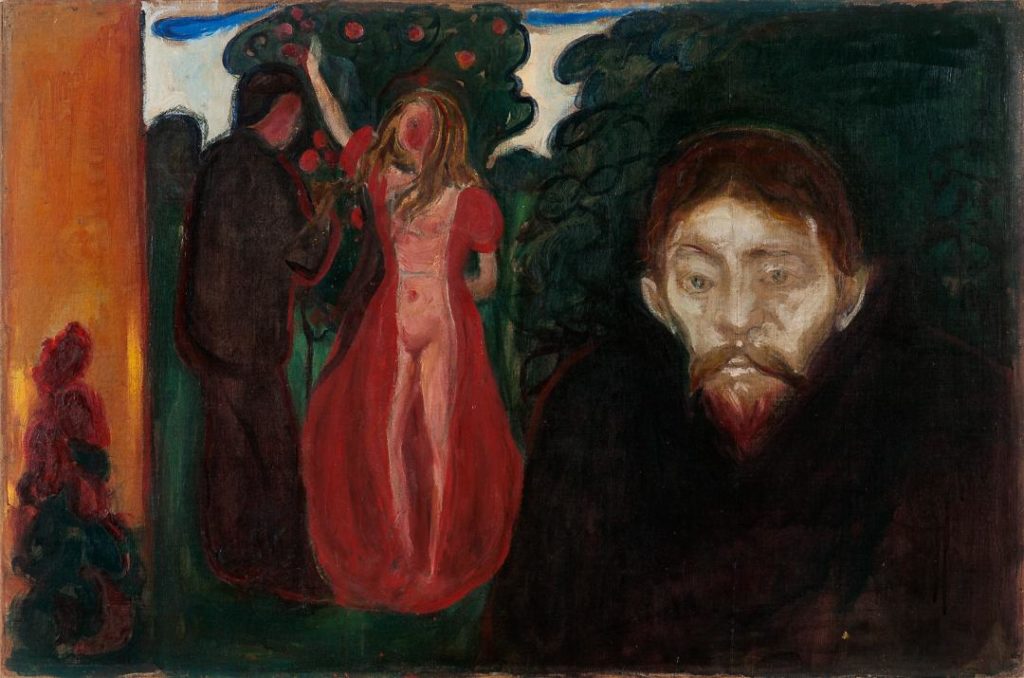
Munch’s relationship with Thaulow had come to an end, but his obsession with her had not. He visited the brothels of Oslo in an act of revenge against the memory of her. Meanwhile, he also found himself in relationships with ‘pure’ young ladies who either bored him or who only saw him through the veil of friendship, that were unfulfilling. It would appear that he could never replicate the feeling he had once experienced: “She was warm and I felt her body close to mine. We kissed long – it was absolutely still in the lofty studio.”
The third section could not have been better named: Anxiety. The dangerous skies full of clashing colors, faces staring out at us, challenging us to say something, crowds creating a claustrophobic feeling of a world that Munch was falling headlong into. There is little to add to this idea, the works speak for themselves.
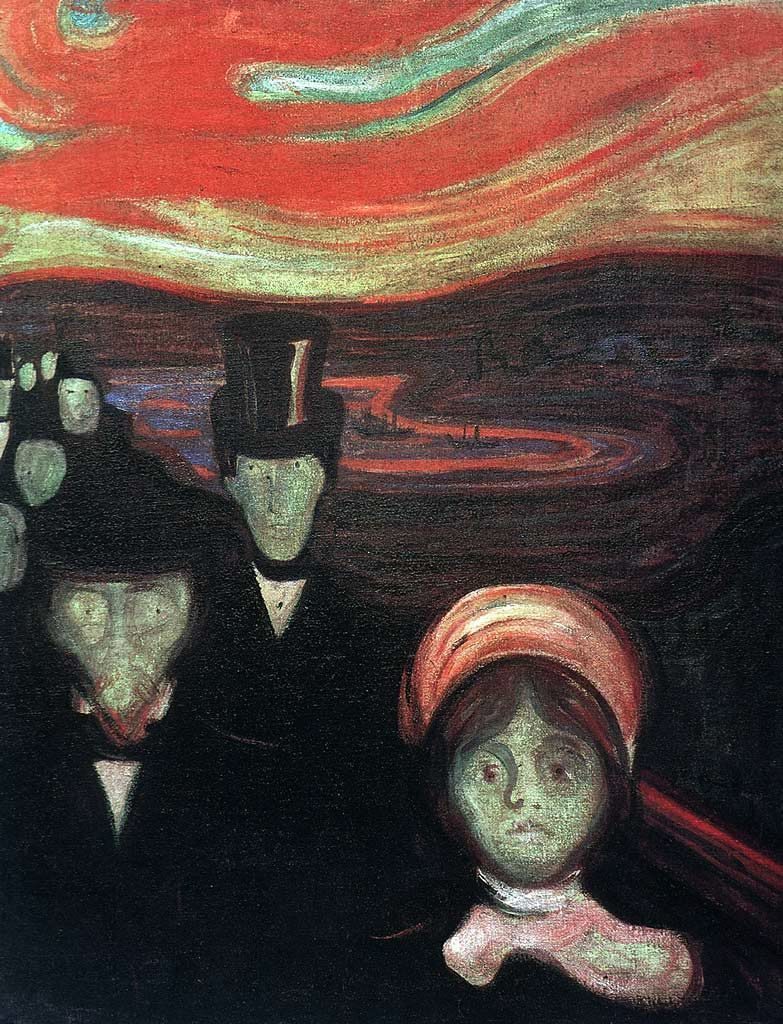
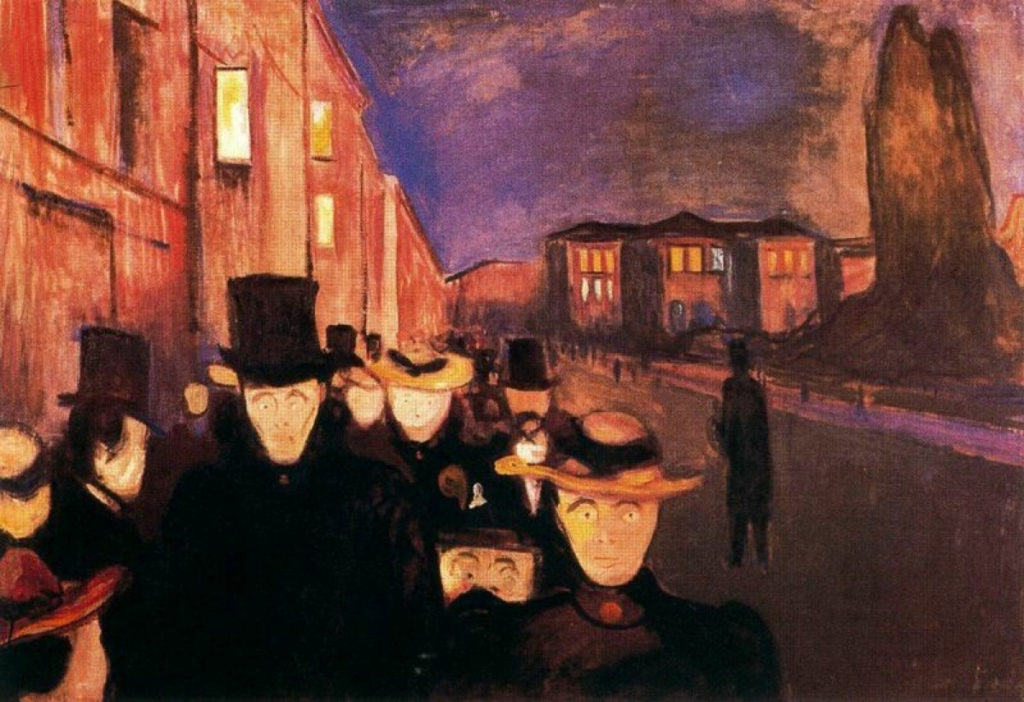
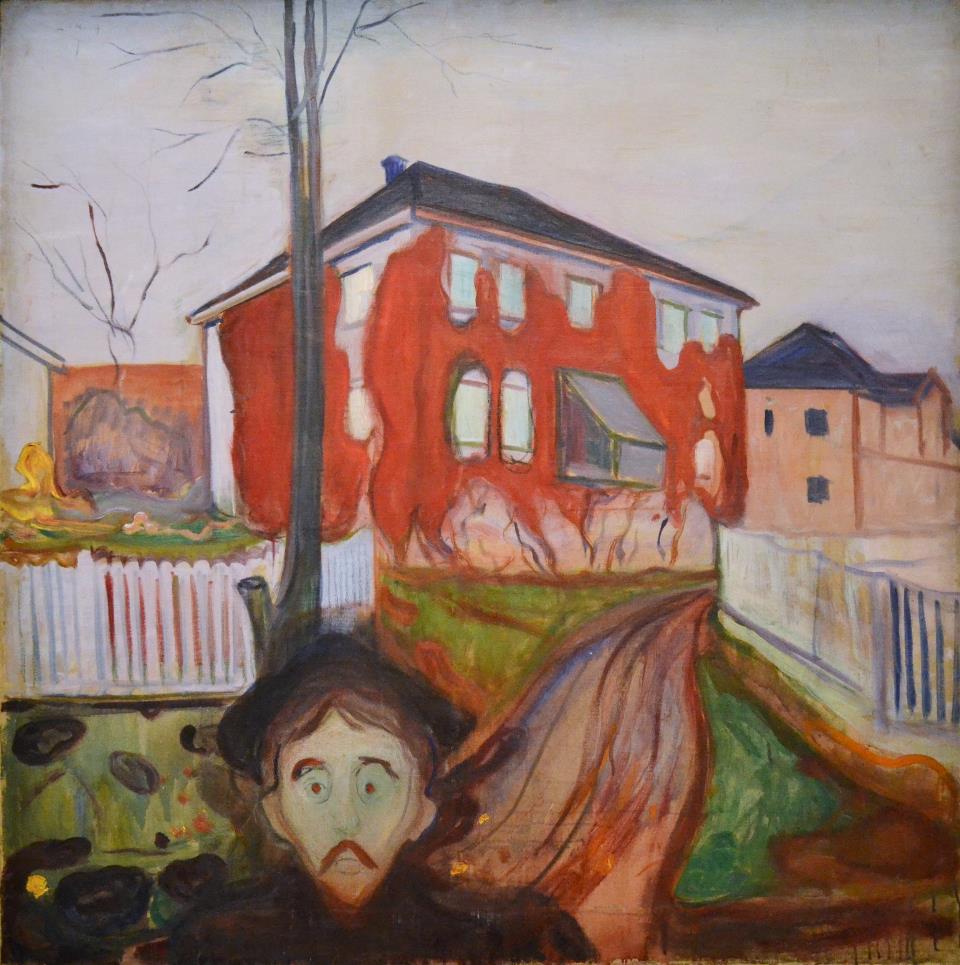
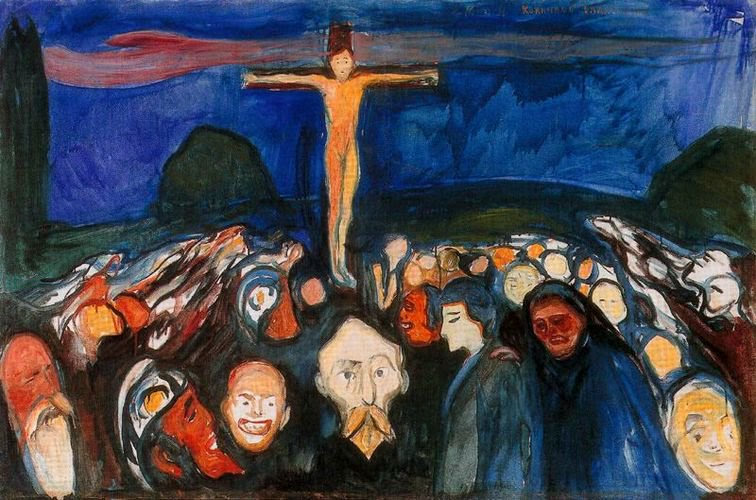
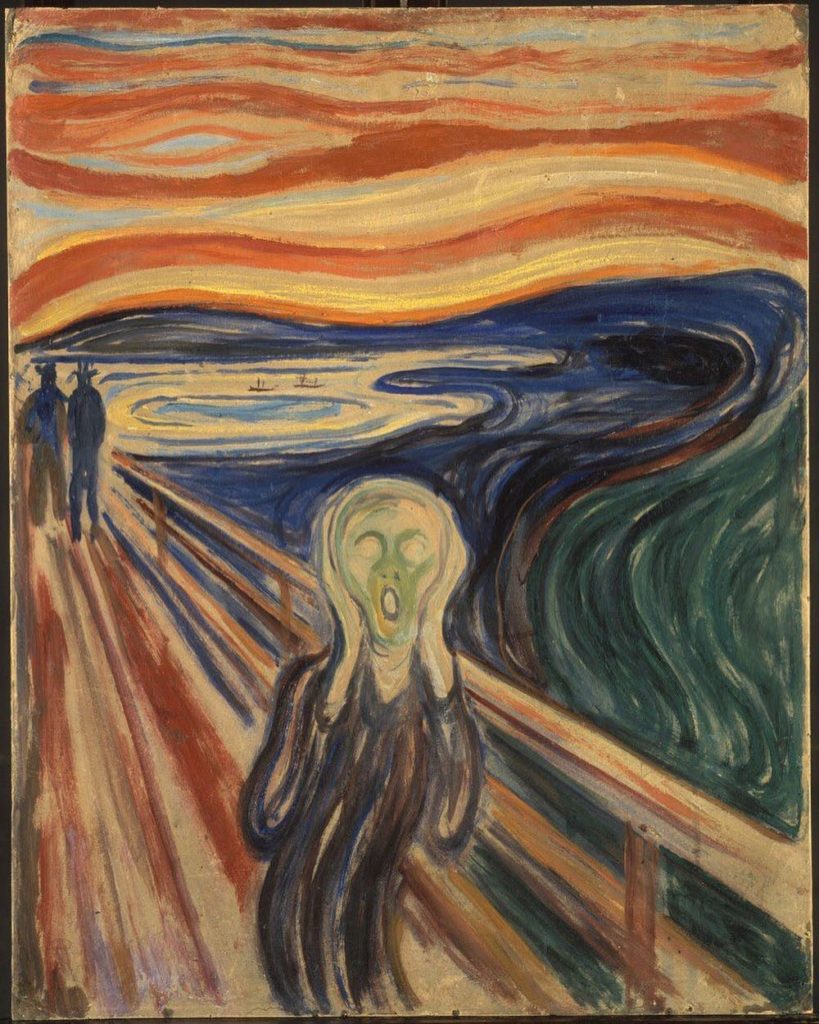
Here you can find out more about the mysterious road from The Scream.
Death was Munch’s constant companion from a young age. The death of his mother when he was seven had a profound effect on the young boy and, therefore, it is not surprising that he dedicated many paintings to the subject.
When Munch’s elder sister Sophie developed tuberculosis and died, she was 15 and had just begun to develop into a woman. Munch would accompany her on the walks she took with her friends, even falling in love with one of them. During her final illness, Munch would be with her as she called out for relief. In his diary, he later wrote that she asked:
‘Dear sweet Edvard, take it from me, It hurts so much. Won’t you please?’ She looked at me so pleadingly. ‘Yes, of course you will. See that head there? It is death.’ But I could not take it away from her. I went behind the curtain and wept.
Edward Munch in Sue Prideaux: Edvard Munch: Behind the Scream, 2005 Yale University Press.
The paintings that appeared in the final section were all linked to the fact that for his whole life, Munch was surrounded by and consumed by illness and death. From his own breakdowns of health that brought him close to the abyss, as shown in The Deathbed Fever, to the death of his mother and sister early on, and his father at a time when he was struggling to find himself as an artist, Munch drew on these experiences to show us the universal pain and suffering that we all endure. As he said in his ‘manifesto’: “There would be pictures of real people who breathed, who suffered, felt, loved.”
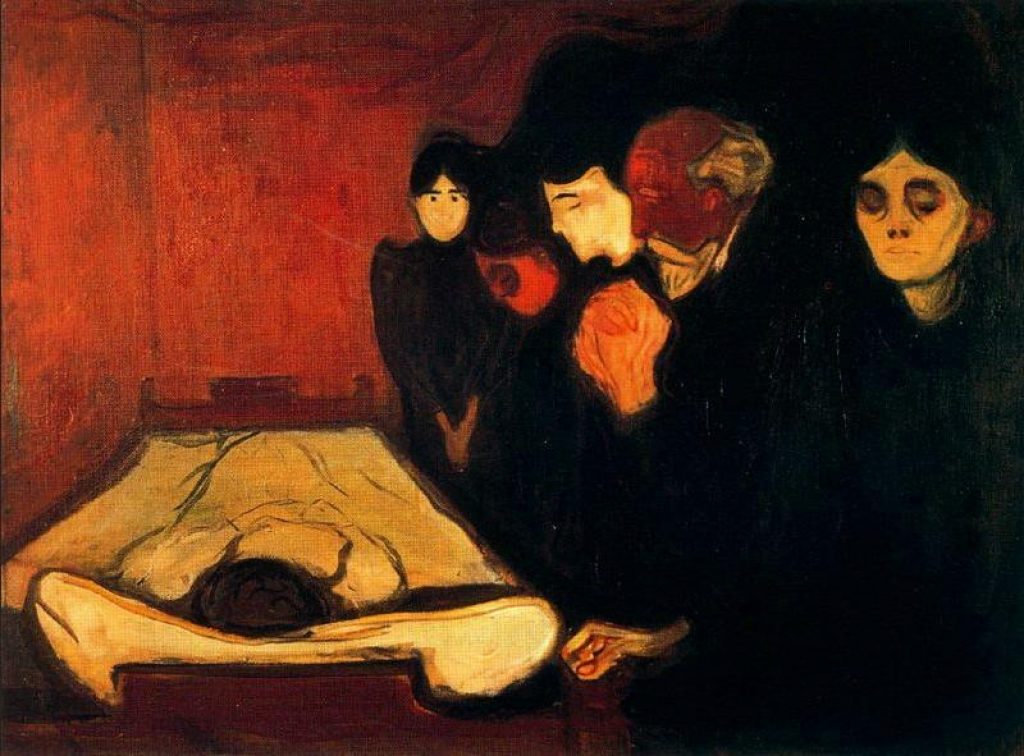
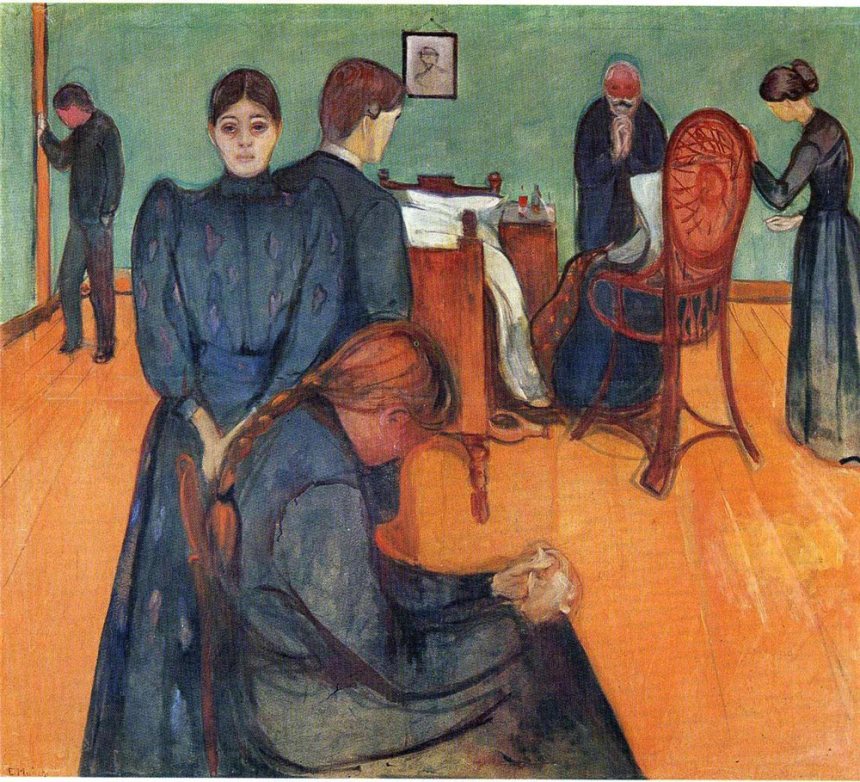
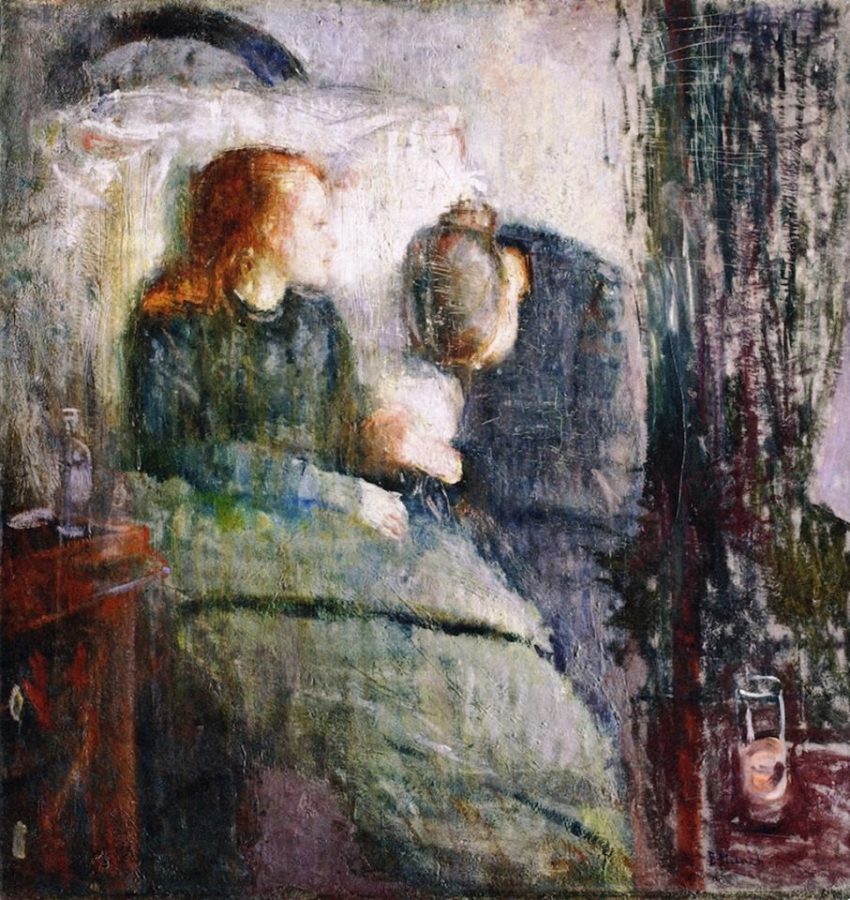
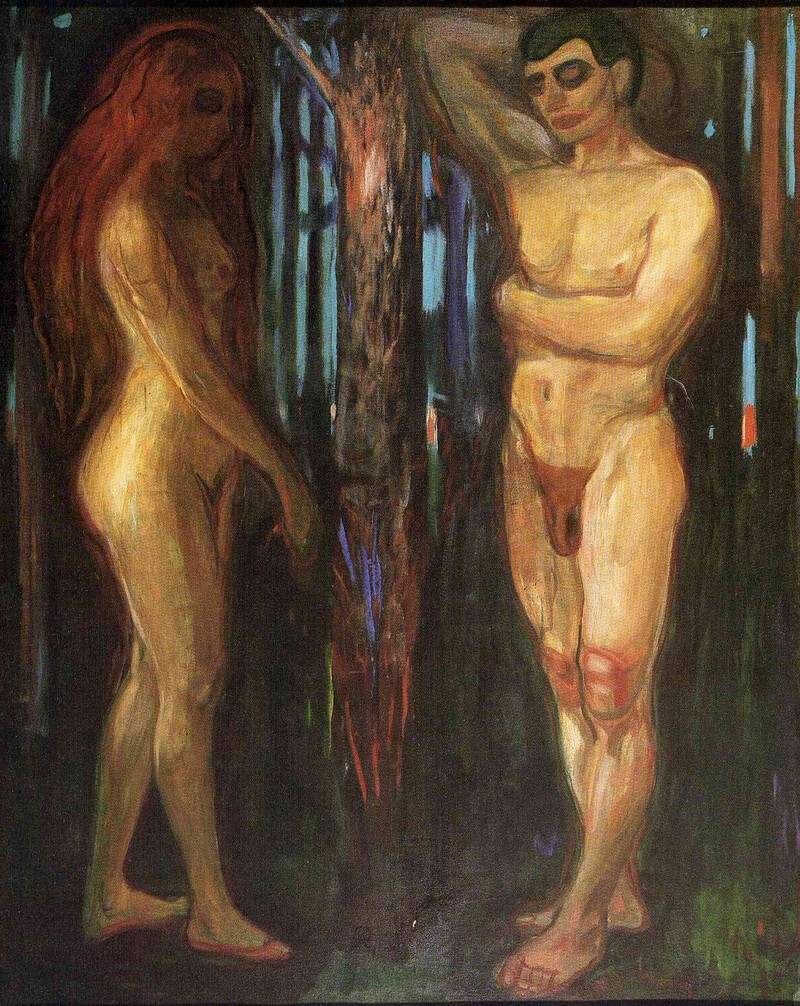
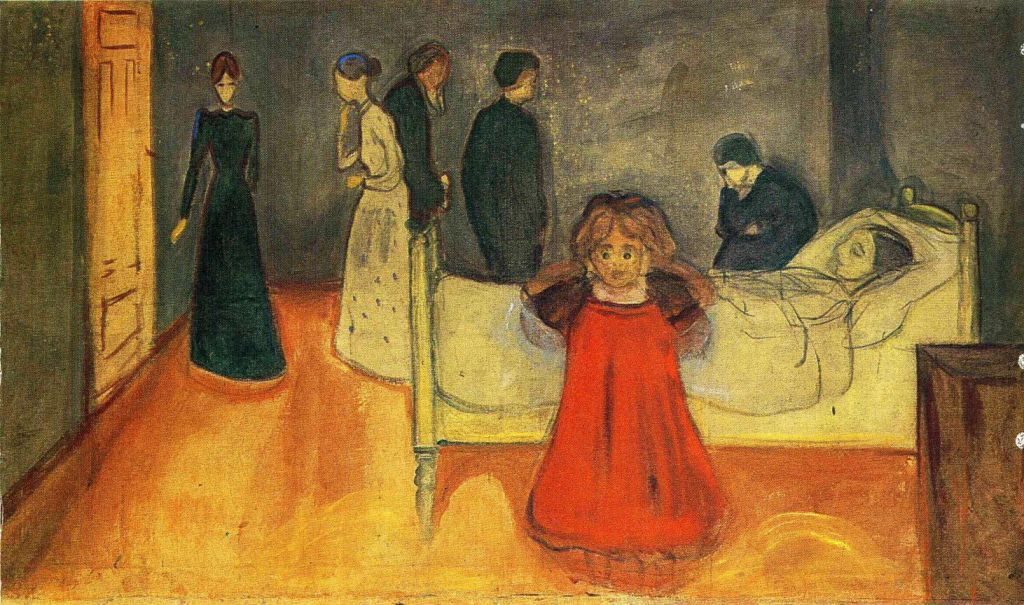
To end this exploration of such an important cycle of paintings that explore all the facets of life and death, Munch should have the final word that demonstrates the success of these paintings, works that we still view today with awe and wonder:
My whole life has been spent walking by the side of a bottomless chasm, jumping from stone to stone. Sometimes I try to leave my narrow path and join the swirling mainstream of life, but I always find myself drawn inexorably back towards the chasm’s edge, and there I shall walk until the day I finally fall into the abyss.
Edward Munch. Sartle.
DailyArt Magazine needs your support. Every contribution, however big or small, is very valuable for our future. Thanks to it, we will be able to sustain and grow the Magazine. Thank you for your help!